

Course Design Framework. • Develop learning strategy: • Remix/reuse/develop course content or accommodate student-generated • Create, outline & describe activities to guide students to apply content • Develop/select assessment methods aligning with course goals, purpose • Identify standards & methods for course evaluation • Gather feedback from varied.
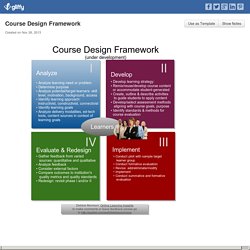
Welcome. Session 2. Day 1 Powerpoint. Day 1 - Introduction to Project Based Learning. Day 1 - The Difference Between Projects and Project-based Learning. Day 1 - Entry Event ideas. Entry Event Resources There are a variety of ways to launch your PBL unit.

Most of all you want the entry event to create excitement in your classroom. The use of video clips, simulations, field trips, guest speakers, and learning games help to engage students and create a desire to venture deeper into the subject matter of your PBL unit. Remember, the entry event should take place on the first day of your unit and it generally takes one class period or less. Let your students enjoy the activity and leave class that day feeling energized and excited about the next step of the project. Resources: Entry Event Possibilities: Video Clips: Websites such as YouTube offer a wide variety of video clips that can be utilized in the classroom.
Day 1 - TWFP Project Timeline on conceptboard.com. Day 2 - Student Handouts. Day 2 - Teacher Tools for the Critical Skills Classroom. Tools for the Critical Skills Classroom is a supplemental resource for teachers, designed to be used in association with the Level I and II Critical Skills Coaching Kit.
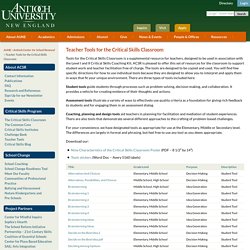
ACSR is pleased to offer this set of resources for the classroom to support student work and teacher facilitation free of charge. The tools are designed to be copied and used. You will find few specific directions for how to use individual tools because they are designed to allow you to interpret and apply them in ways that fit your unique environment. There are three types of tools included here: Student tools guide students through processes such as problem solving, decision making, and collaboration.
Day 2 - Culminating Events // Showtime. Day 2 - Resources for Assessment in Project-Based Learning. Project-based learning (PBL) demands excellent assessment practices to ensure that all learners are supported in the learning process.
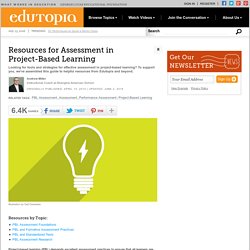
With good assessment practices, PBL can create a culture of excellence for all students and ensure deeper learning for all. We’ve compiled some of the best resources from Edutopia and the web to support your use of assessment in PBL, including information about strategies, advice on how to address the demands of standardized tests, and summaries of the research. PBL Assessment Foundations 10 Tips for Assessing Project-Based Learning (Edutopia, 2011) This comprehensive guide from Edutopia goes over many best practices for assessment, including authentic products, good feedback, formative assessment, and digital tools.
Home-Play - Five Keys to Rigorous Project-Based Learning. Voiceover: How will today’s children function in a dangerous world?
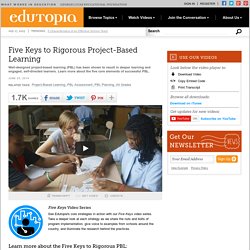
What means will they use to carve the future? Home Play - Managing Your Project. For this week’s Hangout, we were joined by Matt Baer, Dean of Students at Riley Street Middle School in Hudsonville, Michigan, Alicia Peletz, Instructional Coach at Rochester Career Mentoring Charter School, a high school in New York, and Katrina Martinez, Director of the K-8 Legacy Preparatory Charter Academy in Dallas, Texas.

We focused on the following Driving Question: “How can you manage the day-to-day work of students and teams during a project?” Here were some of the highlights: Question 1: How do you prepare students for PBL? Our guests talked about building a culture that supports PBL. Secondary Rubrics. Project Management Skills Map Final. Easing the Pain of Student Collaboration. One of the most valued skills employers are looking for in an employee is the ability to collaborate.

This doesn’t just mean being “nice,” it means being able to be part of a productive and efficient team that gets the job done. And while a significant amount of adult time is devoted to teaching very young kids the basics of playing well with others, as students enter into middle and high school, little attention is given to developing a student’s ability to collaborate. At the same time, every teacher has experienced the pain that comes with student collaboration.
Get started with these sample contracts from New Tech Network, and watch the video below to learn more about team contracts. Who Wants to Know? Use Student Questions to Drive Learning. Martin Luther King, Jr. considered this to be life's most persistent and urgent question: "What are you doing for others?

" As we approach the holiday that honors his legacy, here's another question worth pondering: How many of your students know how to ask persistent and urgent questions of their own? Knowing how to formulate a good question -- and having the courage to ask it -- is a skill with profound social justice implications. Dan Rothstein and Luz Santana, founders of the Right Question Institute, first became interested in questioning techniques when they were working with parents in a low-income community. Parents told them they didn't participate in their children's education because they didn't know what to ask. That was more than 20 years ago. In their important and accessible book, Make Just One Change: Teach Students to Ask Their Own Questions, the co-authors outline a simple but powerful approach to put classroom questions where they belong: with students.
Qualtrics Survey Solutions. Crafting Questions That Drive Projects. Which comes first, the driving question or the learning goals?
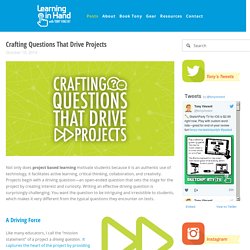
I think it depends. The most successful projects feed off of students’ passions. Don’t be afraid to tap into them. Take what they are interested in and find a way to connect that interest to learning standards. In my first year of teaching, my fifth graders were obsessed with SpongeBob Squarepants. What adventures would SpongeBob have during the Great Depression? Project-Based Learning Lesson Plans. Churchill’s 5 Elements for Persuasive Speaking. Sir Winston Leonard Spencer-Churchill, famed British Prime Minister during World War II, was not only a noted statesman, but also a gifted student of oration and history.
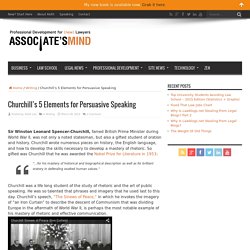
Churchill wrote numerous pieces on history, the English language, and how to develop the skills necessary to develop a mastery of rhetoric. So gifted was Churchill that he was awarded the Nobel Prize for Literature in 1953: A Student's Journey Through Project Based Learning. Assess Student Project Work. Techniques to evaluate progress and ensure success Project work challenges students to think beyond the boundaries of the classroom, helping them develop the skills, behaviors, and confidence necessary for success in the 21st-century. Designing learning environments that help students question, analyze, evaluate, and extrapolate their plans, conclusions, and ideas, leading them to higher–order thinking, requires feedback and evaluation that goes beyond a letter or number grade. The term “authentic assessment” is used to describe assessment that evaluates content knowledge as well as additional skills like creativity, collaboration, problem-solving, and innovation. Authentic assessment documents the learning that occurs during the project-building process and considers the real-world skills of collaboration, problem solving, decision making, and communication.
Developing Assessment As you design the project, it is helpful to begin with the end in mind. Creating a High-Quality Launch for Your PBL Event. One of the trickier components of creating a high-quality PBL experience for your learners is the launch of the project; that period of time where the students are introduced to the question or the challenge they are to face and creating the situation that makes them instantly want to dig in..to have to know more…to solve the problem. The launch (or hook) may be one of the most crucial points of a project because no matter how cleverly a driving question is designed, no matter how well the rest of the project is planned, a launch event can potentially be the make-or-break moment before the project ever leaves the launch pad. A perfect launch can send the project spiraling into perfect orbit, while a poor launch can sputter, fizzle, and never achieve learner lift-off.
Doomsday 1 LifePracticePBL recipe card This is especially true in a classroom where the learners are new to PBL. Project-Based Learning: Why and How? EducationWorld is pleased to present this article by Aimee Hosler, an OnlineSchools.com contributor and mother of two who writes about education and workplace news and trends. She holds a B.S. in journalism from California Polytechnic State University - San Luis Obispo. "Learn by doing.
" A Tutorial on Project Based Learning. A Tutorial on Project-Based Learning.